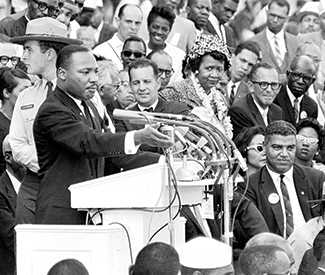news@sfbg.com
Nearly 50 years ago, hundreds of thousands of people marched at our nation’s capital to demand racial equality and respect. And half a century later, people are still fighting for that same cause.
In July, when George Zimmerman was found not guilty of any crimes for fatally shooting 17-year-old Trayvon Martin, racial tensions flared in the Bay Area and abroad. Martin’s death brought the issue of racial profiling to the surface, energizing a new generation of activists just in time for Aug. 28, the 50th anniversary of the Great March on Washington and Martin Luther King Jr.’s “I Have a Dream” speech.
Rev. Arnold Townsend, vice president of San Francisco’s chapter of the National Association for the Advancement of Colored People, is a veteran of the Civil Rights Movement. Townsend told the Guardian that Martin’s death triggered memories of Emmett Till, a 14-year-old African-American who was lynched in 1955 for flirting with a white woman.
Townsend was 12 when Till was murdered, and he says seeing the pictures of Till’s disfigured body in a casket posted in Jet magazine was what inspired him to be actively involved in the movement for racial justice.
“What happens in the world finds ways of bringing people together. What happened to Trayvon Martin isn’t so different from what happened to Emmett Till,” Townsend told us. “I knew that people could come for my father, my uncle, but from this I learned that they could come for me.”
The Zimmerman verdict resulted in large demonstrations of anger and outrage all across the country, including Oakland and San Francisco. The verdict inspired Zack Aslanian-Williams, a 24-year-old San Francisco resident, and others to join the NAACP and become activists.
“There is something about the Trayvon Martin case that definitely impacted my willingness to get involved,” Aslanian-Williams told us. “The case caught fire, and I have a sense of urgency to get involved in any way I can.”
In the wake of the verdict, many new and veteran activists targeted National Night Out, a neighborhood watch program event that African American activists fear fosters the kind of racist vigilantism they say motivated Zimmerman to kill Martin.
Jesse Strauss and more than a dozen other Oakland residents fanned out all over Oakland during the Aug. 6 event, visiting dozens block parties in an attempt to educate people as to why they should be wary of police and wannabe cops.
“We’re doing this to build community and talk to people about real safety,” Strauss said. “I think that the way that police function has been steady, and from that we have so many black and brown people locked up. This is a reflection of the struggles that have been going on and this shows that racism has not stopped at all.”
Rev. Amos Brown, president of the San Francisco NAACP chapter, said he wants to see people come together around racial equality and he fears the targeting of neighborhood watch programs may hinder that goal.
“We don’t need extreme provocateurs,” Brown said of anti-police activists. “The movement is like an airplane, and if one wing is too heavy, the whole thing goes down”
But Brown is just as critical of police, saying the 52 hours of sensitivity training that all personnel at San Francisco Police Department have to undergo isn’t enough.
“If relations were good between them, we would not have numerous calls coming in from people who were profiled by police, immediately being asked if they were on parole when they were approached,” Brown said.
Many San Franciscans are sensitive to the racial profiling issue. Last year, when Mayor Ed Lee proposed a stop-and-frisk policy to combat the proliferation of guns — despite studies showing a similar policy in New York City disproportionately targets African Americans — the community rose up and forced Lee to abandon the idea.
“Being a person of color who has been racially profiled, I couldn’t stand back and let this happen,” says Theo Ellington, president of Black Young Democrats of San Francisco, which organized people against the idea.
But activists say it’s not enough to play good defense. Fifty years after the strong show of support for racial justice, there is still much progress to be made.
“We need to keep pushing forward,” Townsend said. “Success is not measured by what you have done, it’s measured by what you’re going to do next.”
On Aug. 24, the San Francisco chapter of the NAACP plans to head over to Mosswood Park in Oakland for a rally commemorating the march put on by the Coalition of Black Trade Unionists.
The University of San Francisco will also be hosting an event on Aug. 20 to discuss the progress and setbacks in the march toward racial equality since the 1960s. Speakers at the event will include Clarence B. Jones, Martin Luther King Jr.’s former lawyer and adviser, and Mayor Ed Lee.
“It’s important to pause and see what’s happened in the past 50 years. It is the 50th anniversary of the dream and it is important to recognize that there’s been some unraveling of the dream,” USF Vice Provost Mary Wardell-Ghiraduzzi said.
Ellington said he’s still waiting for his own generation’s Great March on Washington. “The death of Trayvon Martin was a wakeup call. It proved that my life, as a person of color, is not as valuable as my counterparts,” Ellington said. “We have to be the ones to turn the tide. There’s still a lot more work to do to fulfill Martin Luther King Jr.’s dream. We are still fighting the same social ills we faced 50 years ago.”

